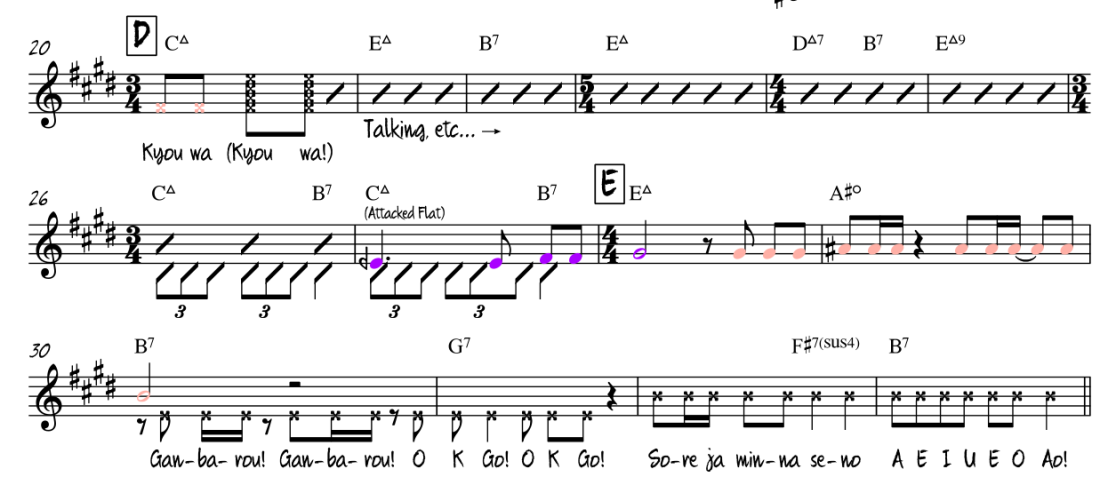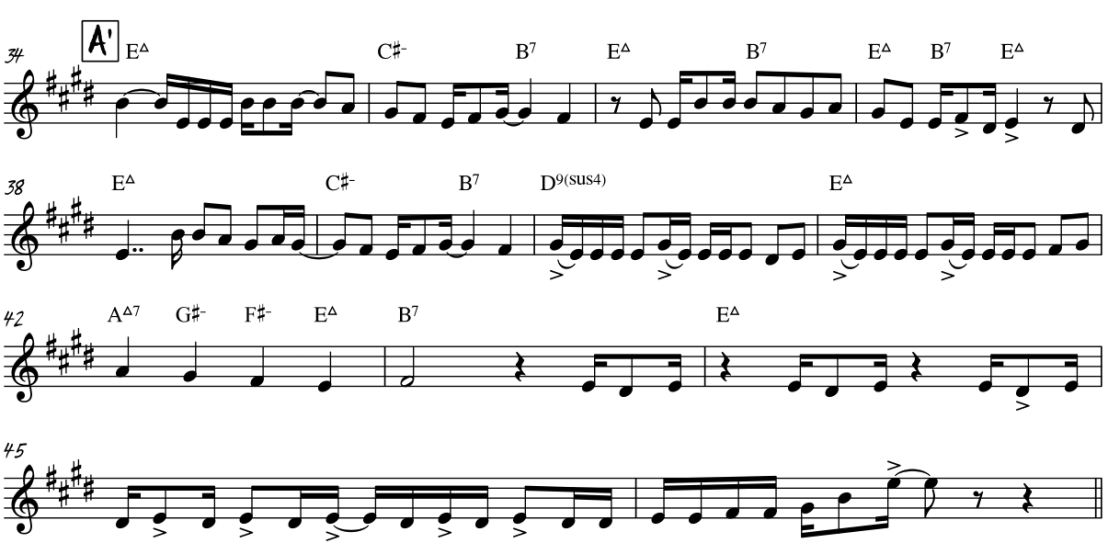Considering my allergies acted up recently and I’m not wearing 5 layers of clothing, it probably means the spring season is here. This means a lot of things, but let’s be honest – you’re here because there’s a new bevy of anime to watch this season. I was initially not too hyped for this season, but as I’ve learned, sometimes the descriptions on Anichart/list/whatever suck. That being said, I’m fairly optimistic about a number of anime this season, so I can’t feel too cheated.
Hinako Note is definitely the definitive CGDCT this season – it’s got a serious GochiUsa vibe to it but leans on theatre tropes a bit more. And it’s a bit more adventurous[?] in other ways…
![[HorribleSubs] Hinako Note - 01 [720p].mkv_snapshot_21.18_[2017.04.15_18.27.05]](https://weebtheory.wordpress.com/wp-content/uploads/2017/04/horriblesubs-hinako-note-01-720p-mkv_snapshot_21-18_2017-04-15_18-27-05.jpg?w=1108)
Both the OP and ED have their weird share of things, but this post is concentrating on the OP specifically. Let’s jump in.
![[HorribleSubs] Hinako Note - 01 [720p].mkv_snapshot_11.07_[2017.04.15_18.25.19].jpg](https://weebtheory.wordpress.com/wp-content/uploads/2017/04/horriblesubs-hinako-note-01-720p-mkv_snapshot_11-07_2017-04-15_18-25-19.jpg?w=1108)
Hinako Note OP Analysis
A E I U E O Ao! by Gekidan Hitotose
Key: E Major
PDF is here.
Crossed Notes are spoken word. Slash notes are notated rhythmic nuances.
Form: Intro, A, B, C, A’, B, Coda
Intro-A

It start off innocuously enough until measure 6, then it goes into a weird torrent of offset beats. This beat division is odd to say the least. m6-7 denote an odd broken cross-rhythm – it’s basically another conflicting rhythm happening on top on an existing one. Technically, going by that definition, any music passing any other music can be considered cross-rhythmic, and that’d put you right into the seats of Charles Ives and many other avant-garde folk that were pushing textbook definitions. A common conventional cross-rhythm that exists is the clave rhythm. Here, the cross rhythm I’ve notated in blue – it’s a series of 16th + 8th notes:

- Why are some eighth notes split into 2 16ths? Beaming. It’s important that you still signify where the major beats in the primary time are – it’s still there underneath it all, anyway.
Over the course of almost 4 bars [barring a 16th] we’ve squeezed in roughly 5 beats – the cool thing about cross-rhythms in general if the fact it obscures the primary rhythm and can kind of shift a feel in a piece. Some cross-rhythms are fairly difficult to execute [this one in particular is nasty!] because keeping track of the primary rhythm can prove difficult to those without training/exposure to it.The red I’ve highlighted is where the cross-rhythm breaks – there’s an added 16th, presumably to fill up the rest of the rhythmic space nicely so it can still end up on the downbeat. This makes it way harder to execute in general, though – it’s essentially an intended stutter in the flow of a cross-rhythm, which seems counter-intuitive to its very existence. Them’s the breaks, though, quite literally.
A “fixed” version (a version that maximizes the cross-rhythm) would look like this:

B Section

Pipopipopipopepo or something
The black sheep in this section is the 5/4 over there – but you can think of it as a cadential extension – it does what it says [extends a cadence to delay the resolution]. It’s also worth nothing there’s literally no harmonies here minus the open 5th, so it’s all just chromatic attacks on the tonic here. (1->7->b7->7->1, 1->b3->2->b2->1, etc)
C Section

Primary verse. A call and response, with another two instances of cadence extensions at the end. You may notice the use of Eadd#4 – make no mistake, it isn’t a #11 , jazzheads. The bass arpeggiates between 1 and 5, but uses 1 and #4 in the following measure to destabilize the sound a little. Very oddball effect. The response the 2nd time around gets its own response as well, oddly enough in 4. Why put the 5/4 earlier? It makes it visually identical to the previous response and the drumbeat clarifies the down beat there as well.
D+E Sections

And now we’re in 3. I think the large amount of talkspam so a great job in masking the downbeats here, and beats 4 and 5 in m23 allow a hard reset of where the downbeat is felt, and it sort of a way to reestablish the feel. Going into E, we have the 3 again emphasizing triplets in order to give rhythmic tension going back to regular 4/4.
Harmonically this is the most interesting of the music. Up until now, we’ve had mostly our usual I [vi subs every now and then] and our Vs. Most of the other stuff also had no chords and were just unison chromatic lines, save for the oddball #4 from before. The Roman Numerals for D go as (bVI -> I -> V -> I -> bVII -> V -> I -> bVI -> V ->bVI -> V). A lot of borrowed chords from E Minor’s scale does some great work in being subdominant substitutes. E is a little weirder: (I -> viidim/V -> V -> bII/ii -> IIsus4-> V). A series of secondary substitutes makes it sound slightly more uplifting, and really ramps up the tension to resolve to the I when A’ hits. Bonus – the B acts as a pedal tone throughout m30-33 and acts as a big V anchor for the I chord following. Really drives the point home there.
A’ Chorus

Back to A, and now it’s twice as long! The first 4 measures are identical to the beginning A, minus the weird cross-rhythm cadence, and then it repeats it again – then halfway through we get an odd left turn into some new material: D9sus4 acts as a subdominant chord for E (bVIIsus4 -> I) and extends the phrase a little more. And then we get some planar motion in m42 into the V chord (IV -> iii -> ii -> I -> V), which cadences into another odd cross-rhythm ending. Here, the cross-rhythm is broken further? It maintains alternating D# and E until the last half-beat of m45, but we can write that off as a pickup to the final measure shown. This really extends the cadence for a full 1 1/2 measures. This one makes slightly more sense than the one in the beginning, though it may be due to listener’s bias. [We’re expecting it be just as stuttered as the earlier one, but the fact it stays within 4/4 and has accents spaced more evenly means it works in our ear better than we think.]
Ending

Nothing too big to note here. Same deal as before, and uses the last part of D to round out the song. Note the vox slide is one continuous motion; such are the limitations of notation software.
And that pretty much rounds it out. I’m interested to see how the full version of the OP will round out- and how they got the seiyuus to sing the thing in the first place. I think there’s some heavy evidence of post-production splicing going through the audio slowly, which might even explain the odd breaks I’ve noted. An definite oddity in this plane of the anime world.
![[HorribleSubs] Hinako Note - 02 [720p].mkv_snapshot_21.12_[2017.04.15_21.40.13].jpg](https://weebtheory.wordpress.com/wp-content/uploads/2017/04/horriblesubs-hinako-note-02-720p-mkv_snapshot_21-12_2017-04-15_21-40-13.jpg?w=1108)
~Angular
